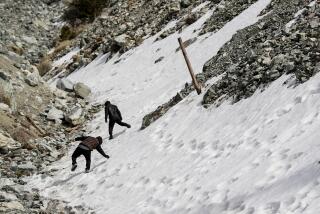‘A Change in Altitude’ by Anita Shreve
Acute mountain sickness affects people at high altitudes. Symptoms include dizziness, confusion and fatigue. In her 15th novel, “A Change in Altitude,” Anita Shreve writes about it knowledgeably. Perhaps she was suffering from it as she wrote, because this novel is a mess.
Shreve can be an excellent writer. It’s easy to understand why her work appears on bestseller lists. Usually her prose is clear, her descriptions elegant and her plot twists surprising and original, enticing us to keep turning pages.
One of her great strengths is her ability to get inside her characters. From 12-year-old Nicky in “Light on Snow” to Maren Hondtvedt, the 1870s wife in “The Weight of Water,” her protagonists are multi-faceted, complex and believable. Even when they are stubborn or unlikable, Shreve makes us understand and sympathize.
Yet none of this is apparent in “A Change in Altitude.” The novel’s heroine, Margaret, is bland and prosaic. She is newly married and, as the book begins, new to Africa -- where the novel takes place -- as well.
In the opening sentence, Margaret’s husband, Patrick, announces a plan to climb Mt. Kenya in two weeks. But there is no reaction, just a series of references to the creases in his clothing, their nonfunctioning toilet and that horse meat is cooked for the dogs.
Even after Patrick elaborates -- “We climb. We hike,” he says. “Parts of it will be rough” -- Margaret has no response. Instead, she thinks of her landlady’s car and that the bedroom they occupy seems to be furnished for a writer. She has no feeling about the climb, no anticipation, no opinion, except to say that she needs hiking boots. And yet, this climb is the centerpiece of the novel, the fateful event that has the power to change everything.
It is the hiking boot salesman who recognizes the expression on Margaret’s face.
“And what would that be?” she asks him.
“Fear.”
Again, Margaret skims past any emotions, other than a petty worry about haggling over the price. After she leaves, she has samosas and banana-coconut ice cream. We know more about what she eats and wears than anything she feels. Throughout the upheavals and reversals to come, she remains as flat as cardboard.
When she and her husband are robbed of everything they own, she says only, “I’m so sorry.” She is a stranger to him and also to us. Worse than that, she is incredibly dull.
But if Margaret is the biggest problem with “A Change in Altitude,” there are other issues, beginning with when the novel takes place. It’s nearly 30 pages before an overheard snatch of conversation mentions Jimmy Carter’s inauguration. Blink and you miss it -- and any sense of chronology.
More important, why are we in Kenya in 1977? The Mau Mau rebellion had taken place 20 years earlier. President Kenyatta has been in office for 13 years.
An observation Margaret makes about an old Olivetti typewriter makes it seem as if she had never seen one -- and yet in 1977 everybody used typewriters. There are anachronisms in attitude and dialogue. “I so wish you hadn’t said that,” Margaret says. I so wish she hadn’t either.
At one point, Margaret tells Patrick that she can’t accompany him on a business trip because she has to work. But on the very next page, she is preparing to leave.
The use of a guidebook to explain the history of Mt. Kenya is a strikingly amateurish device. What purpose do these facts have to the story? Why is she “intrigued”?
Other characters are just as one-dimensional. A receptionist, Grace, is described as having “an acerbic wit worth hanging around for.” But almost the only thing we hear her say is “You must go home. . . . We are not needing you here.” Hardly witty or acerbic.
When the one interesting character gets deported, it’s a relief. He was too good for this book.
It’s obvious that Shreve has done her research: She knows Kenya and, indeed, this whole part of Africa; she understands the difference between Ugandans, Asians and Luo.
But that is not enough to make a novel. Throughout the book, Shreve’s prose feels rushed. “She was chewing gum from a pack she’d bought in Nairobi,” she tells us. “She never chewed gum. She nodded.”
Why did she never chew gum? Why is she now? Details are overlooked and descriptions are pedestrian. An affair, an unwanted pregnancy, a plane crash and an obsession with tennis all get equal weight. In the end, it all seems contrived and predictable.
“In her bathrobe,” Shreve writes, “her hip resting on the sill, Margaret examined the untended garden. . . . How many months or years had it been since a gardener had weeded the walkways, thinned the bougainvillea, clipped the lilies? If she had the energy or the courage, she would call the Sikh and offer to bring the garden back to life.”
Shreve needs to spend less time in the upper altitudes and more weeding and pruning this plain old garden. Her fans -- and there are many -- will buy this book. I would recommend waiting for the next one.
Wagman is the author of the novels “Skin Deep,” “Spontaneous” and “Bump.”
More to Read
The biggest entertainment stories
Get our big stories about Hollywood, film, television, music, arts, culture and more right in your inbox as soon as they publish.
You may occasionally receive promotional content from the Los Angeles Times.






